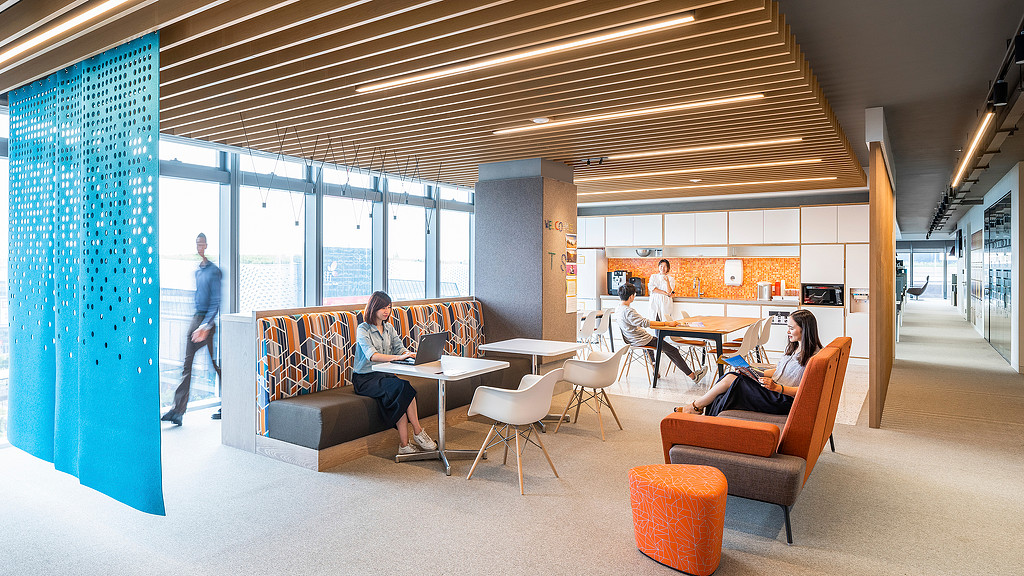Lessons From China: What Hybrid Work Really Looks Like in Practice
May 19, 2021 | By Janet Pogue McLaurin
When COVID-19 first hit in early 2020, China was the first country impacted and the first to recover. After a brief lockdown and amidst strict protocols, office workers emerged from working from home and returned to the office by late spring 2020. While the rest of world continues to be in various stages of still dealing with the pandemic, China quietly returned to the office and their cities began to open up. COVID cases are extremely low, and have been for nearly a year. The Chinese workplace is back open — and the experience of these workers holds lessons for the rest of the world as we consider what a hybrid workplace future really looks like.
For our latest China Workplace Survey (WPS), Gensler surveyed 3,000+ professional workers in China to understand how, and where, they were now working. We wanted to learn from those already living in a post-pandemic workplace and glean insights on lessons learned that we could apply in other countries as vaccines take hold and it becomes more feasible to begin to return to the office.
We surveyed China office workers in January 2021, right before the Chinese New Year. Most workers had transitioned to working from home briefly in early 2020 and had already returned to the office — unlike the U.S. or many other countries where over half the workforce continues to work from home full-time. In China, less than 1% of survey respondents were still working from home full-time at the time of our survey.
Here are a few insights that we’ve gleaned from our workplace research in China, and lessons for other countries, employers, and those who occupy office space around the world:
1. Employees are back in the workplace. Work has changed, and the physical office needs to change too.Employees really want to come back to the office first and foremost to work with colleagues. They have missed each other and the sense of belonging that working together creates. The office in China is more collaborative than ever. But, office workers also still see the office as key location for their focused work — the office in China today continues to support the full range of work modes and activities.
Very few Chinese companies made physical changes to the office beyond enhanced cleaning and policy changes before returning. Office workers in China have reported struggles with noise and distraction in the office as it comes back to full capacity, particularly with the added increase of virtual collaboration. Although work behaviors have changed, the space is still designed to support the former way of working, with no cues for new behaviors or new space types.
The post-pandemic workplace is an opportunity to fix what didn’t work before, and create a physical office space that provides the ideal mix of both open environments and access to private spaces for individual work requiring intense quiet and focus AND virtual collaboration or group work, which may be noisy and distracting. People are surprisingly resilient — employees will quickly return to their old behaviors when they return to the office unless we take intentional care to foster even better behaviors in the future.
2. Senior leaders will draw their workforce back, but their needs must be balanced with the needs of their staff.The perspective of senior leaders is important not only because they drive decision-making, but also work process and cultural norms. According to our survey, 75% of senior leaders in China report their jobs heavily rely on in-person collaboration; 72% rely on impromptu collaboration/connection, and 79% say their jobs rely on specific spaces in the workplace. If senior leaders rely on in-person work most, they’ll expect that those who they collaborate with should also be at the office. This may have the unintended consequence of cascading through an organization and draw the rest of the workforce back to the office as well.
As our survey revealed, it’s important to acknowledge that staff and leaders work differently in many ways. Staff rely less on in-person collaboration and specific spaces in the office, and value being around their team, socializing with colleagues, and learning for professional development. While staff still want to spend most of their workweek at the office, they have enjoyed the flexibility of working remotely and have successfully adapted new virtual collaboration tools and behaviors. As leaders return, it will undoubtingly create a gravitational draw back to the office, a culture of “presence,” and an expectation that staff must be there too. The frequency and cadence of working remotely will need to be carefully choreographed. Intentionally balancing everyone’s needs will be critical for a successful hybrid workforce comprised of people with unique and different needs.
3. Pre-COVID perceptions of remote work are surprisingly persistent — we’ve always been in the office less than we think.Senior leaders still report a complex view of remote work — while nearly all agree that remote work enhances productivity, a majority of senior leaders also note concerns about its adverse effect on career advancement and team cohesion. Yet working this way is not actually new for Chinese workers. Workers in China were highly mobile, even in 2016, which was our last pre-pandemic survey. Chinese workers today spend an average of 3 days working from the office, and 1-2 days working remotely — but their remote work time is spent slightly more in coworking sites, alternative office locations, cafés/third places, and client sites than actually working from home.
In China, cities have opened up and business travel has resumed, allowing more opportunities to work remotely throughout the workweek. This mobility is also driven by high levels of choice among the Chinese workforce — four out of five workers report a choice in where they work during a typical week (though number drops to 63% for non-managers and more junior workers). For those working both in and out of the office, choice has a positive impact on personal and team productivity, job satisfaction, creativity, and the ability to solve problems. In 2016, we measured that the most innovative companies had more choice, spent 26% working remotely (or 3.5 days in the office), and spent more time away from their desks. Remote work is not just working from home. As cities in other countries also begin to open again, remote work from other office locations, coworking sites, travel, and third places will pull even those full-time in the office staff back out of the office once again.
Ultimately, I see a bright future for work and the workplace in the lessons from China. The changing dynamics we’ve experienced over the past year will (hopefully) yield a global workforce with more choice and autonomy in when and how to work than ever before — and an understanding that most workers will continue to desire and choose the workplace as their primary work location, borne out of a recognition of its positive effects on productivity, as well as the social connections and sense of community that just can’t be re-created remotely.
As organizations look forward, we have an opportunity to redefine the role of the office, not going back to what was, but to continue to move forward with an enlightened view of work and a renewed focus on people and how they work best. The office matters more than ever. Let’s entice employees to return by making the office space worth the commute!
For media inquiries, email .

